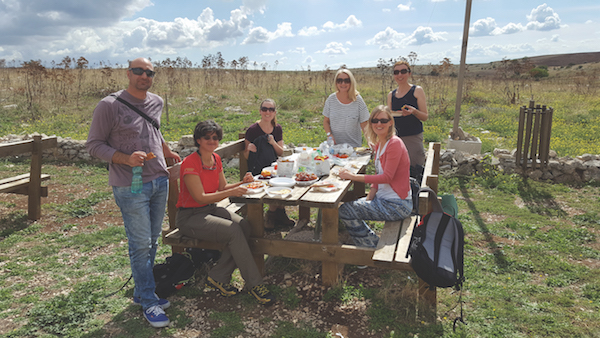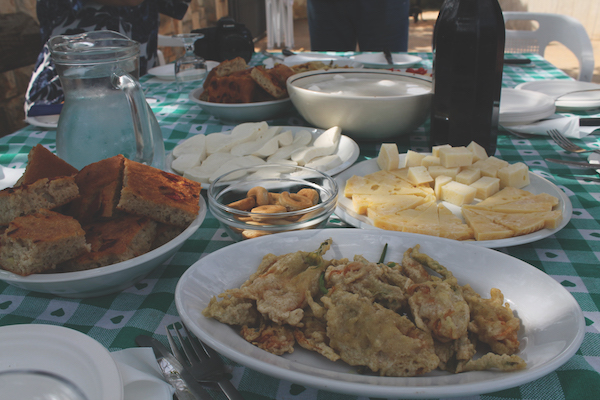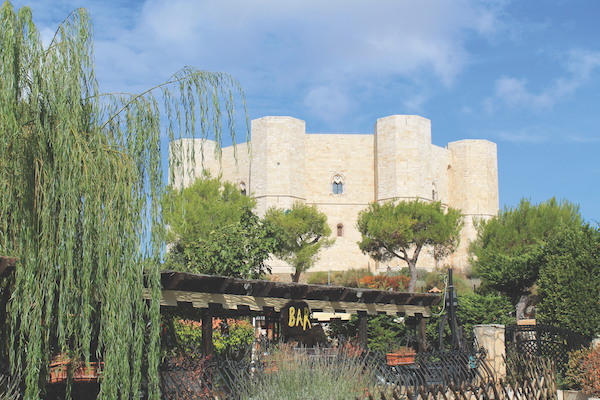Mark Nicholls follows the culinary contours of Puglia on a walking – and eating – tour around this unique region of southern Italy
Words and photos by Mark Nicholls
The darkened inner walls of the baker’s oven begin to glow as the fire takes hold. With a long-handled tool, the baker loads the creamy-coloured dough of the famed Altamura loaves into the far depths of the cavernous wood-fired oven, spreading some 320 of them around evenly to absorb the heat. These oven walls of the Di Gesù bakery in an Altamura sidestreet have hosted rising loaves for more than a century and, in that time, will also have heard a tale or two.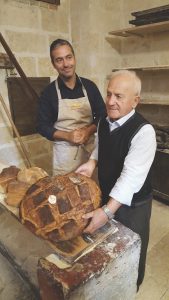
When the Di Gesù bakery first opened it was, like many, a community facility where local women brought cherished dough to be baked into bread for the family. While waiting for their loaves to rise, they would sit in the warmth of the bakery telling stories, gossiping and match-making. And the oven walls would hear all… But never retell. Each family would have a bread stamp to identify their own loaves, which take an hour to bake, explained bakery owner Giuseppe di Gesù. Today, while not acting as a community oven, the Di Gesù bakery continues to bake bread in a town that has given its name to the famous hard-crust loaves – the only town in Italy with a DOP (protected designation of origin) recognised bread.
The Provenance of the Food
We had arrived in Altamura on the latest stage of a walking and foodie tour of Puglia with travel company Explore, which specialises in small group adventure, activity and cultural holidays. Talk of food, as we soon discovered, is never far away in Puglia – a land famed for its bread, cheese, wine, fresh produce, and of course its olive oil. Thankfully, our foodie tour of the region had that critical element of exercise, with a walk 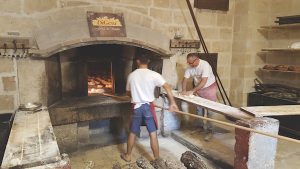 – either to work off the calories or to build up an appetite – which meant we were always ready to taste the next local delight and also learn about the provenance of the food.
– either to work off the calories or to build up an appetite – which meant we were always ready to taste the next local delight and also learn about the provenance of the food.
As the ‘heel’ of Italy’s ‘boot’, Puglia is growing in popularity as a must-go destination, including attracting some A-list celebs (Justin Timberlake married here, for example). With a rolling landscape of whitewashed towns, unique trulli-style round houses and ancient masserie (fortified farmhouses) dotted amid thousands of acres of olive trees, and a rugged coastline never far away, the appeal is clear. And of course, no visit to Puglia is complete without a pause in Alberobello, in the wine-producing area of the Itria Valley, famous for its iconic trulli buildings – the traditional dry stone huts with a conical roof, and perhaps the most photographed feature of the region.
My visit to Puglia had started in Cisternino, a town particularly famous for its butcher’s shops, which serve the local barbecued delicacy known as bombette – little meat parcels filled with mince, ham and cheese – as well as other grills. It’s a great tradition here, in this town dominated by a clock and square: you buy your meat at the butcher’s, have it cooked and eat it with salad, potatoes, prosciutto and local wine at a canopied table in one of the quiet alleyways with flowers tumbling over balconies and window ledges nearby.
We had also walked across the arid, rolling landscape, over the mysterious last resting place of Neanderthal man and toward Altamura, where, alongside visiting the bakery, we also learned how to make pasta by hand – capunti, orecchiette and spaghettoni – at the Tre Archi restaurant.
Puglian olive oil
But if there is one product that defines Puglia, it is olive oil. Millions of trees produce the staple of the Mediterranean diet, with many farmed by smallholders who bring their olives to be processed at the local olive oils mill such as Il Frantolio, which produces oil using both a traditional and a modern press during the October-January harvest. While Il Frantolio processes the olives for farmers, each waits for their oil to be produced, anxiously ensuring that the oil they get is from their olives. “They know exactly what their oil should taste like, with each grove having its defining flavour,” explains Angelita Amati from the mill, which also has a museum and offers tasting sessions. In the traditional method, the olives are pressed by large stones wheels, with 100 kilos of olives 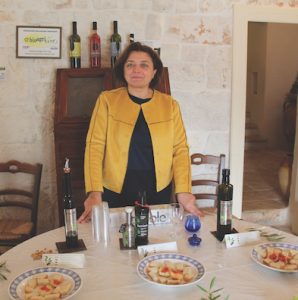 delivering 12-14 kilos of extra-virgin olive oil within four hours. However, a mechanised production line produces oil within 45 minutes and also has the capability to create flavoured oils such as orange or lemon and many more.
delivering 12-14 kilos of extra-virgin olive oil within four hours. However, a mechanised production line produces oil within 45 minutes and also has the capability to create flavoured oils such as orange or lemon and many more.
Angelita adds, “From picking the olives to getting to the mill is twelve hours, which is crucial for the acidity – the higher the acidity, the lower the quality. Farmers recognise their own olives and their own oil because of the taste; each orchard is different. The olive oil mill is very much about what Puglia is about, the passion, the taste and the welcome.”
Puglia accounts for more than 40 per cent of Italian olive oil production. Explaining that when you are tasting olive oil – it should be sweet at the front of the mouth, salty at the side and bitter and spicy at the back for extra-virgin olive oil – Angelita says, “If it is good, it will leave your mouth clean, fresh and dry.”
Puglia also has several agriturismo centres, such as Nuovo Muretto, where Anna Casulli demonstrates to visitors how to make mozzarella trecce (“plaits”) and nodini (“little knots”). It is an opportunity to taste the freshly-made organic cheeses and enjoy a lunch that includes courgette flowers in batter, mountain-style hard cheese, peppers laden with bread, egg and cheese, tomato focaccia and homemade wine followed by homemade pasta and tomato sauce. Anna uses curd from the previous day’s milk which is chopped into smaller segments and worked with very hot water and kneaded like dough. It is stretched into lengths and shaped before being dropped into cold water to halt the souring process. All produce for the lunch – and cheeses – is close by: the cows, which provide the milk, laze in the field opposite the farm and gardens and orchard where the fruit and produce is grown.
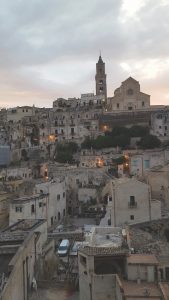 Our visit also included a trip to Matera, just across the provincial border in Basilicata. A fascinating destination steeped in history and culture, it will be European Capital of Culture for 2019. Approaching the town on foot, the imposing tower of St Eustachio’s cathedral is dominant as you walk across the rocky plateau with the scent of thyme drifting on the breeze from the herbs growing beside the path.
Our visit also included a trip to Matera, just across the provincial border in Basilicata. A fascinating destination steeped in history and culture, it will be European Capital of Culture for 2019. Approaching the town on foot, the imposing tower of St Eustachio’s cathedral is dominant as you walk across the rocky plateau with the scent of thyme drifting on the breeze from the herbs growing beside the path.
While the main town is now centred around the 16th-century squares and alleys, courtyards and cobbled paved streets, lavish baroque buildings, churches and cathedrals, the two revived sassi quarters of Sassi Barisano and Sassi Caveoso tumble away below. It is here that we find our hotel, the aptly-named Hotel Sassi with 35 rooms in the Sasso Barisano, created out of the cavern homes that once housed families. From my room, the view of the cathedral is spectacular, washed in orange with the lights of evening. It will be just as mesmerising the following morning at dawn, in a starker light across the pallid stone and moss-covered roof tiles below.
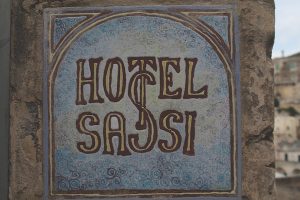 The final day of our walking foodie tour of Puglia sees us head toward the mysterious
The final day of our walking foodie tour of Puglia sees us head toward the mysterious
Castel del Monte, the 13th-century citadel and UNESCO World Heritage Site which provided the inspiration for Umberto Eco’s novel The Name of the Rose. Soaring above the surrounding Puglian countryside this is a powerful edifice, yet, with neither moat nor defences, it raises questions as to what its true purpose was.
Today, however, from its elevated position on the top of a 500-metre mound, the way it imposes itself on the hinterland is undeniable. Visible from quite a distance, it acted as a landmark as we walked towards it through cherry orchards and across rock-strewn fields where tumbledown trulli are the only remnants of shelter. Here, the cone-roofed houses are semi-derelict and abandoned, unlike the pristine examples in Alberobello. We trudge past them on the last leg of tour of Puglia, eating up the miles – as well as the cuisine – lured by the beacon of Castel del Monte.
This is a landscape of stone walls and flowers, with the final stretch up through woodland towards the castle, which has shone brightly with its pure white stone for miles. After the visit we do what has become second nature: descend to the plain for an agriturismo lunch to nourish us after another mesmerising journey through the region’s irresistible contours.
More information
Explore offers an eight-day Taste of Puglia trip from £1,295 per person including flights, transfers and some meals. The trip includes the pasta making, olive oil and wine tastings, and visits to the bakery and cheese farm, as well as walks of between 1-3 hours on five of the days. For more information call 01252 884723 or visit www.explore.co.uk

